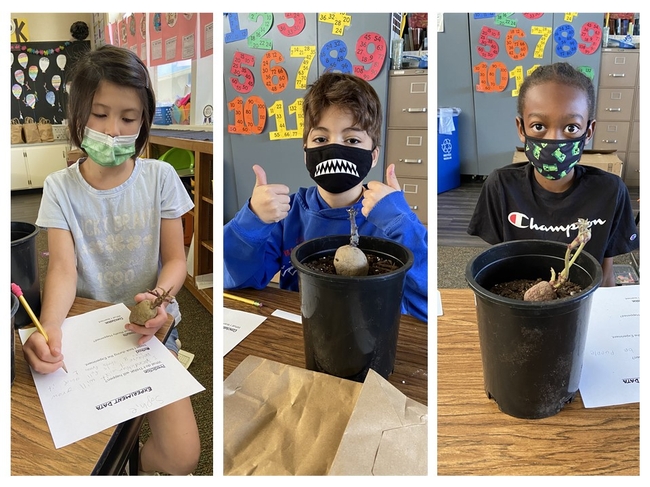- Author: Caleb Crawford
- Author: Elizabeth J Fichtner
Scheduling irrigation events based on crop use allows growers to meet the water demands of crop production wile reducing both the risks of over- and underwatering. Together with improvement of irrigation system efficiency, the integration of the crop water use concept to irrigation scheduling may additionally aid growers in adhering to policies designed to conserve water.
UCCE has partnered with the Department of Water Resources (DMR) to generate weekly Etc reports for almond, pistachio, citrus, raison grapes, wine grapes, walnuts, and stone fruit. The Etc report is an estimate of the weekly soil moisture loss for each crop based on weather data gathered from CIMIS (California Irrigation Management Information System) stations. For the southern San Joaquin Valley, the report is based on data from the following six CIMIS stations: Merced, Parlier, Lemon Cove, Panoche, Five Points, and Stratford. For each crop, local UCCE farm advisors have monitored leaf out in the spring to make estimates of when to start the current irrigation season. Because leaf out may vary extensively by variety, the leaf out date estimates are selected at the approximate midpoint for a given crop. To use the Crop Water Use Report, select the crop of interest as well as the closest CIMIS station to the block in question to determine the approximate water use for the past week as well as the accumulated water use in the current season. Additionally, the report allows growers to estimate water use in irrigation systems with varying efficiencies, and to estimate the number of gallons applied per tree or vine over the prior week. Last, the Water Use Report provides an estimate of the next week's ETc based on an average from previous years.
The Crop Water Use Report is located on the UCCE Tulare County website (https://cetulare.ucanr.edu/) under the agriculture section in the Nut, Prune, and Olive Programs. It is also emailed out weekly from the UCCE Fresno County office. If you would like to be added to that electronic mailing list, please send an email to Mae Culumber (cmculumber@ucanr.edu).
The Etc reports provide valuable estimates of crop water use but are not a substitute for a grower's direct measurement of water stress using tools such as the pressure chamber. The water use report, however, does provide a “cheat sheet” for growers to use as a reference for their irrigation practices. Growers should consider local weather conditions, the exact leaf out dates of varieties under their management, the efficiencies of their irrigation systems, soil type, and historic water use and crop production information to customize irrigation practices at each site.
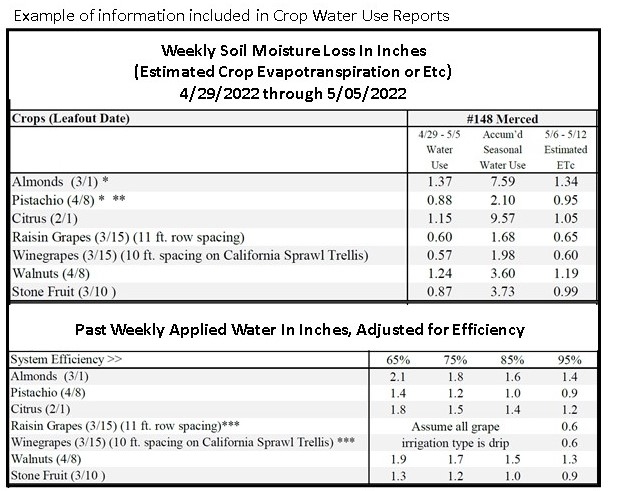
- Author: Elizabeth J Fichtner
- Author: Dani Lightle
- Author: Themis Michailides
- Author: Emily Symmes
- View More...
Walnut scale (Quadraspidiotus juglansregiae) is a common pest of walnut throughout California's Central Valley. Populations of the pest in commercial walnut orchards (Figure 1 A and B) appear to have increased over the past decade, inciting a recent surge of research on the biology and management of walnut scale. University of California researchers have recently monitored crawler emergence patterns in multiple walnut growing regions, thus improving the phenological models utilized in timing insecticide applications. Other studies have focused on evaluation of insecticide chemistries for management of the pest, including softer insecticide chemistries and insect growth regulators (IGRs). Additionally, walnut scale has been found to interact with canker-causing, plant pathogenic fungi in the canopy, thus exacerbating diseases that may further compromise orchard productivity (Figure 1 C, D and E).
Despite its name, walnut scale is not unique to walnut. It is native to North America and has a wide host range including woody shrubs, deciduous plants, and conifers. In California, walnut scale populations sampled from commercial orchards all represent a single species; however, the population composition of walnut scale across other hosts and regions has not been assessed at a genetic level. In California walnut orchards, walnut scale has historically been considered a minor pest. In the past decade, the insect has transitioned from an orchard inhabitant to a pest as the effective insecticides for walnut scale control have been cancelled.
The causes of walnut scale's recent emergence as a pest are not fully understood. It is speculated that populations of walnut scale are higher than historic levels. The interaction of scale with canker fungi, such as Botryosphaeria spp., may also be a new relationship for walnut scale. These pathogenic fungi have recently emerged as economic pathogens of walnut despite having been previously endemic in California. Generally, disturbances in natural or agricultural ecosystems may induce changes in the roles of ecosystem inhabitants, such as insects, pathogens, weeds, and other microbes. For example, prior to the introduction of DDT and other similar chemical insecticides for the management of codling moth, scale insects were not considered economic pests of walnut orchards in California. Utilization of these insecticides disrupted natural enemies (Figure 1F) of several scale species, resulting in a disruption in the orchard ecosystem and necessitating management of scale populations.
Walnut Scale and Botryosphaeriaceae. Walnut scale predisposes trees to infection by Botryosphaeriaceae fungi both directly and indirectly. A direct association between scale and fungal infection is observed when the scale body is lifted from the shoot to reveal a developing canker (Figure 1D). In this direct interaction between the scale and the pathogen, the feeding activity of the insect likely created an infection court (mode of entry) for the pathogen to infect and colonize the branch (Figure 1E). Infestation of twigs by walnut scale also predisposes new growth to infection and disease development. In this indirect interaction between the insect and the pathogen, the canker develops on plant tissue that remains uncolonized by the insect (Figure 1C). Research studies with three different pathogens in the Botryosphaeriaceae family suggest that disease levels are 60-70% higher on branches colonized by scale than on uncolonized branches.
Walnut Scale Identification. Walnut scale is an armored scale with a scalloped waxy coating (Figure 2). The adult female scale is revealed by lifting the waxy coating. The body of the adult female walnut scale can be differentiated from that of the San Jose Scale (a non-native armored scale) by the ridges on the body. Conversely, the adult female San Jose Scale has a smooth body and a pronounced nipple on the coating (Figure 2).
Walnut Scale Lifecycle. Walnut scale nymphs overwinter in orchards and metamorphose to the adult stage in spring. The females remain non-motile but the adult male is winged and able to fly. After mating, the females lay eggs and the eggs hatch in two to three days and then the crawlers emerge. Crawler emergence is in late April to mid-May in California, depending on the climate and location. For example, initial crawler emergence has been observed as early as mid-late April in Contra Costa andTulare County orchards, and as late as
early May in Tehama County orchards (Table 1).
Female crawlers move around, allowing the scale to colonize the current season's shoots. Once a female crawler finds a place to settle and begin feeding, she secretes the scale cover. Male crawlers migrate to the margins of the female cover and settle. Initially the scale cover is white, but it changes to gray or brown in about a week. The female then goes through two instar stages and the male goes through four instars before maturing to the adult and a second generation is initiated in the same season. Second generation crawlers emerge in late July to early August with crawler populations peaking in late August to early September. Second generation crawler activity is generally complete by the end of October; however, at some sites, crawlers may be active into mid-November. These second-generation crawlers will settle and molt before winter.
Detection of Crawler Emergence. To target insecticide applications to the crawler stage, double-sided sticky tape can be wrapped around walnut scale-infested branches in mid-April (Figure 3A). Emerging crawlers stick to the tape as they navigate to find feeding sites. Tapes should be changed weekly and checked under a magnifying glass to observe crawlers (Figure 3B).
Chemical Control. Walnut scale can be managed with either broad-spectrum insecticides or IGRs. IGRs are a preferable tool for use in an integrated pest management program because they are less disruptive to natural enemies than contact insecticides. IGRs work by disrupting the molting process; therefore, their activity is not realized immediately but rather over time as the insect develops. When applied at the delayed dormant stage (ie. March), IGRs would have the opportunity to inhibit the maturation of the overwintering scale to the adult stage. When applied in late spring (ie. late April-early May), IGRs may impact egg hatch as well as the development of the first-generation nymphs.
IGRs including buprofezin and pyriproxyfen are effective for management of walnut scale. In UC trials, pyriproxyfen was only tested as a delayed dormant application, whereas buprofezin was tested at both at the delayed dormant and the crawler stage timings. In season, the delayed dormant buprofezin application was superior to the crawler application for reducing crawler populations; however, applications of the product at either timing yielded similar suppression of scale populations in the subsequent season. Only one IGR application per year should be adequate for management of the pest. Effective monitoring and decision-support can help determine the need to treat on a yearly basis. For more information, on monitoring visit the Sac Valley Orchards website (https://www.sacvalleyorchards.com/walnuts/insects-mites-walnuts/walnut-dormant-monitoring-and-treatment-decisions/).
Products other than IGRs also exhibit efficacy in walnut scale management. In UC trials, acetamiprid, spirotetramat, and bifenthrin/imidacloprid, when applied at the crawler stage, were effective for scale management. The full impact of both spirotetramat and bifenthrin/imidacloprid were not fully realized until the following season.
Summary. Walnut scale had become an insidious pest in walnut orchards. Orchards with high disease pressure caused by fungi in the Botryosphaeriaceae family will benefit from both management of walnut scale and pathogens. If populations of the scale are high, or appear to have increased recently, it may be time to apply an IGR for scale management. IGRs may offer scale suppression over multiple years and often the efficacy of products may not manifest until successive seasons due to the mode of action.
For more information on walnut scale and other pests and diseases of walnut, visit the UC IPM website (ipm.ucdavis.edu). Research reports from studies conducted with support from the California Walnut Board are posted online (walnutresearch.ucdavis.edu). Mention of any particular chemistries or trade names does not constitute a recommendation and are for informational purposes only. Always consult with your licensed crop consultant and adhere to the pesticide label and local and state regulations. Additionally, check with certifier to determine which products are organically acceptable.
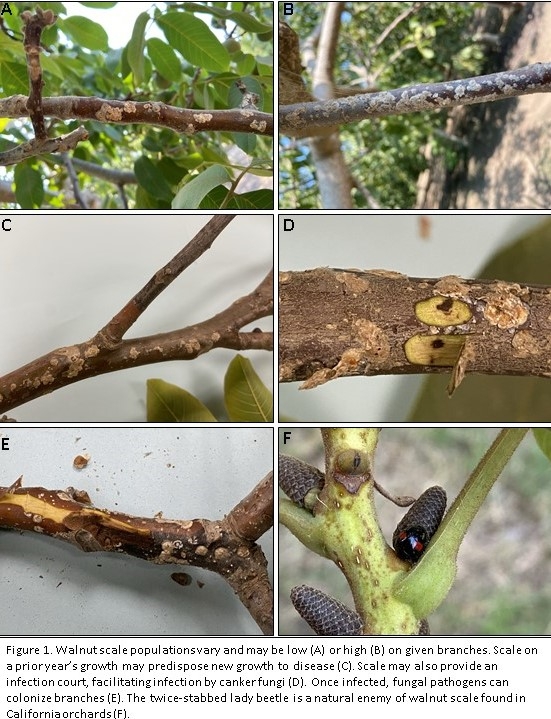
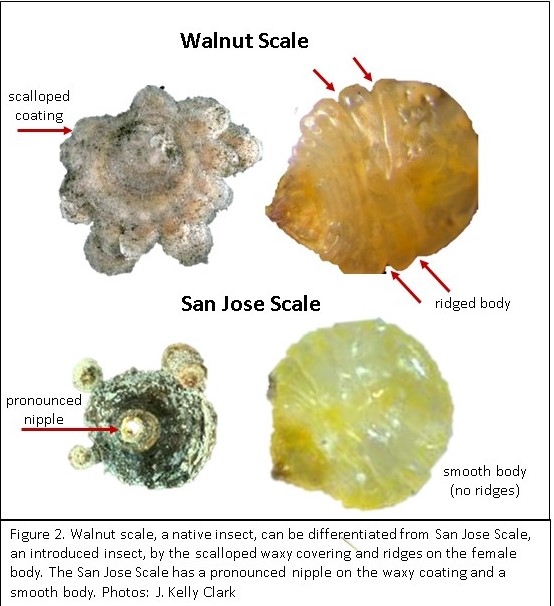
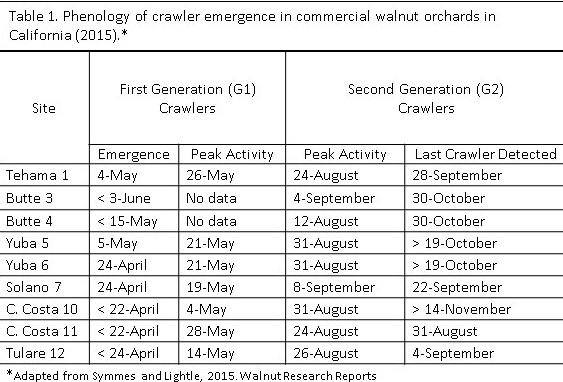
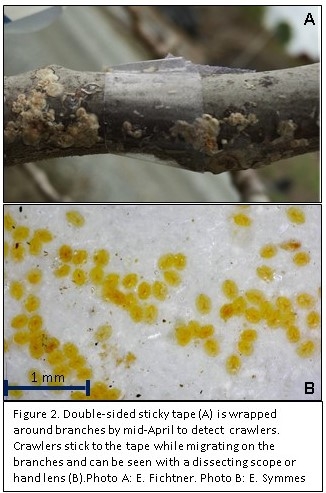
- Author: Elizabeth J Fichtner
On December 10, 2021 the UC ANR President's Advisory Commission on Agriculture and Natural Resources, joined by the new UC President, Michael V. Drake, MD., visited both the Lindcove Research and Extension Center and the UCCE Tulare County office for tours and hands-on presentations highlighting the research and extension activities conducted by our local UC ANR Farm Advisors and CE Specialists. Personnel from UCCE offices in Tulare, Kings, Fresno, and Madera Counties, under the directorship of Karmjot Randhawa, joined the Commission for a farm to fork luncheon followed by a meet-and-greet opportunity to display programmatic efforts in the lobby, ranging from a 4H display on slime-making to agricultural displays on diagnosing plant pests and diseases.
Elizabeth Fichtner and Caleb Crawford organized an olive oil tasting, allowing Commission members to taste local olive oils pressed by Bari Olive Oil Co. (Dinuba, CA) and perceive the oil characteristics associated with different varieties. The hands-on activity fostered conversation of the unique challenges facing the table olive and oil olive industries in California, as well as UC researchers' efforts to address these industries' needs in pest and disease management, harvest technology advancement, and crop management.
Nut crop advisors, Mae Culumber, Doug Amaral, Phoebe Gordon, and Elizabeth Fichtner prepared a visual display of research activities conducted on almond, pistachio, and walnut in the region. The combined programmatic emphases of the four advisors target a wide range of topics including nutrient, irrigation, soil salinity, tree canopy management, as well as the identification and management of pests and diseases affected orchard productivity and nut quality. The Almond Board of California, the California Prune Board, San Joaquin Figs, and the American Pistachio Growers all contributed materials for inclusion in gift bags presented to the Commission members. A bottle of Bari olive oil was also provided for each guest.
Events such as this allow local UC ANR advisors to interact directly with UC administrators and provide impressions of the valuable work conducted by UC ANR within our local communities. The UC system is both large and diverse, but the UCCE system facilitates engagement of communities at the county level, fostering research and extension opportunities that contribute to the institution's reputation as a world-class system of higher education.
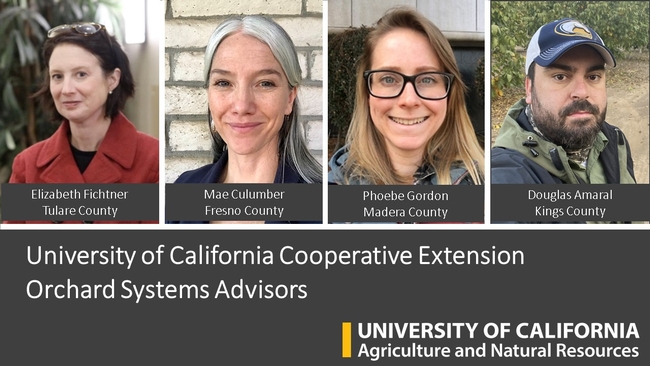
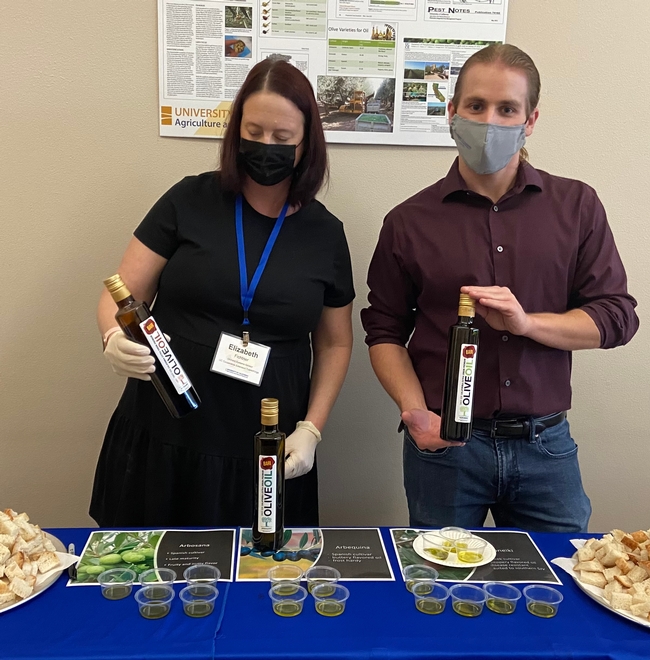
- Author: Elizabeth J Fichtner
Freeze damage was reported in commercial walnut orchards throughout California during the winter of 2020. Although comprising the southern tier of the state's walnut-growing area, Tulare and Kings County orchards were not exempt from freeze damage. The damage caused by freezing temperatures in the fall are not perceptible until budbreak and leaf out the following spring. As a result, the extent of winter freeze damage is often not fully realized until well into the following season.
Walnuts are most susceptible to freeze occurring in late fall and early winter, prior to onset of full dormancy. Freeze damage may be caused by either an abrupt or rapid decrease in temperatures or a large fluctuation between day and night temperatures. Both the probability and extent of freeze damage are mitigated by climatic conditions that allow for a gradual acclimatization of the trees to colder temperatures as they enter dormancy. Prior to complete dormancy, low temperatures of 22°F to 28°F may induce freeze damage; however, fully dormant trees may withstand lower temperatures (below 20°F) without sustaining damage (Sibbett, et al., 1998). Tree health and soil-water status may also influence the occurrence of freeze damage (Sibbett, et al., 1998). For example, during the winter of 2020-2021, dryland farmed mature walnut trees in Lake County were killed by freezing temperatures, whereas irrigated trees in the region did not sustain the same damage (Elkins, R. June 2021).
Freeze damage identified in young Tulare County orchards was likely caused by freezing temperatures in late November and early December 2020 (Figure 1). For seven consecutive days (11/26-12/2) temperatures plunged below freezing. This timeframe was also characterized by a large difference between high and low air temperatures, as indicated by the arrows in Figure 1. Greater differences between high and low temperatures are associated with an increased likelihood of freeze damage.
Diagnosing freeze damage is largely based upon the distribution of the symptomatic trees in the orchard as well as the distribution of tissue damage on individual trees. Freeze damage may appear in low areas of the orchard where cold pockets of air settle (Figure 2A). Affected trees may be adjacent to unaffected trees (Figure 2B). The outermost branches may die back but buds closer to the ground may survive and push in the spring (Figure 2C). Rootstocks are often less suscept to freeze injury due to the re-radiation of heat from the ground; however, excessively cold temperatures or cold air trapped by an inversion may offset the benefit of radiated heat from the soil surface. To diagnose freeze damage on a given tree or tissue, expose the cambium below the bark and look for darkened tissue. Growers may consider the potential to retrain scaffolds from surviving buds and shoots. The decision to retrain vs. replant may be based upon several factors including tree availability in the nursery trade, number of viable buds remaining, and overall extent of damage in the orchard.
Several methods have been suggested for preventing freeze damage in walnut orchards (Jarvis-Shean, 2016). Limiting nitrogen application and irrigation in September and during the post-harvest time will reduce the production of succulent shoot growth that may be more susceptible to cold damage as temperatures drop. Additionally, research studies conducted by Bruce Lampinen, CE Specialist, UC Davis, demonstrate that painting the trunks and shoots with dilute (50%) white interior latex paint after leaf fall will reduce the extent of temperature fluctuations at the plant surface, particularly on the southwest side of the tree. Studies conducted by Wilbur Reil, Farm Advisor Emeritus, demonstrated that application of the paint after a freeze event can still mitigate the damage.
References
Elkins, R. 2021. Cause and management winter injury sustained in Lake County in 2021. Your North Coast Orchard Notes (Issue 3). June 2021.
K. Jarvis-Shean. 2016. Sac Valley Orchard Source. Avoiding Freeze Damage. (https://www.sacvalleyorchards.com/walnuts/horticulture-walnuts/avoiding-freeze-damage/)
Sibbett, S., Coates, W.W., Edstrom, J. 1998. Orchard Planning, Design, and Planting. In: Walnut Production Manual. UC ANR Publication 3373.
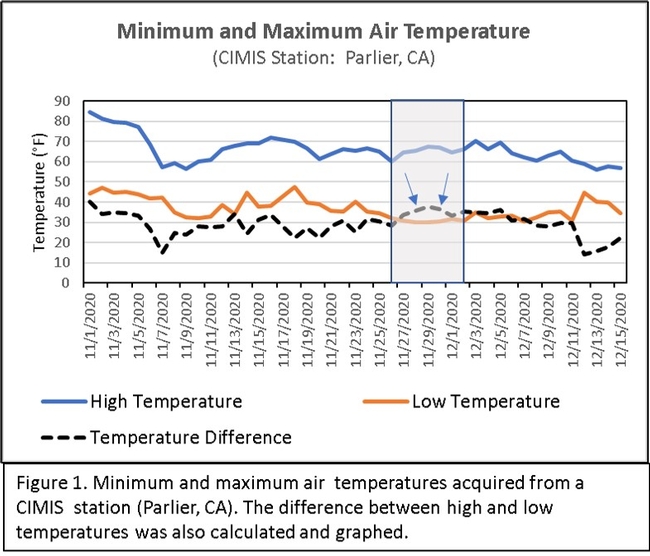
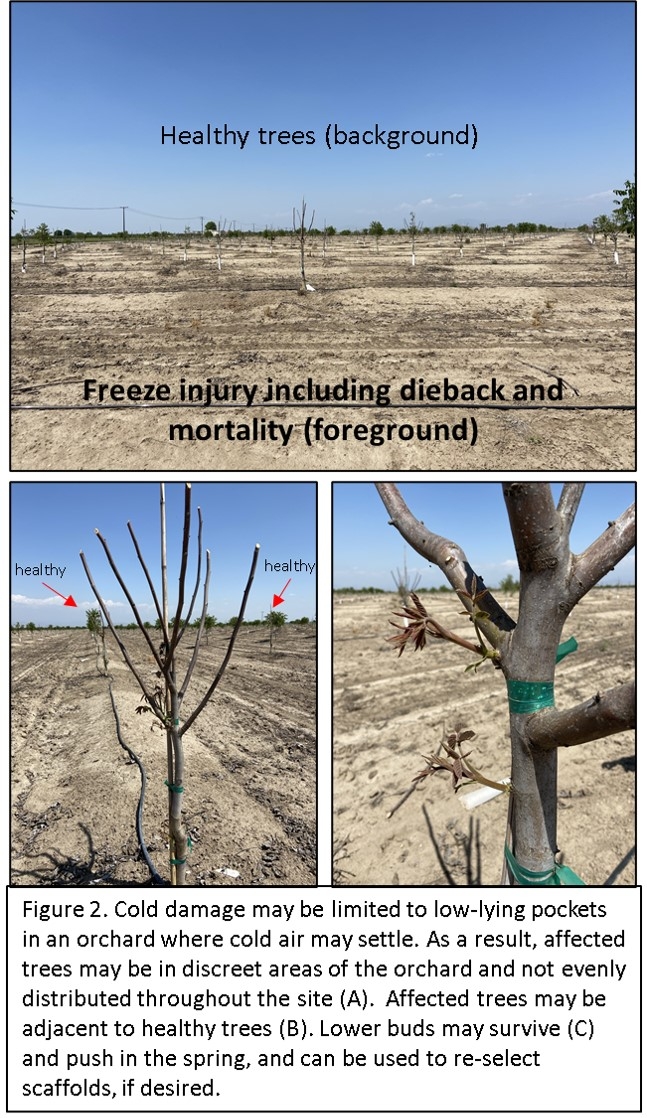
- Author: Elizabeth J Fichtner
Pandemic-related school closures left our school gardens underutilized and limited students' opportunities for hands-on science projects that typically promote AG literacy in K-12 education. To mitigate the loss of these valuable educational opportunities, the Tulare County Farm Bureau (TCFB) actively engaged local teachers to bring agricultural concepts to the virtual classroom by unveiling a competitive grant program open to Tulare County teachers. Each sponsored project received support of up to $500 to integrate AG literacy programming into virtual classrooms.
Utilizing TCFB financial support and leveraging support from our UCCE Tulare County office, Mrs. Honley and I collaborated to deliver two AG education projects integrating with the third-grade science curriculum. In November 2020, 90 kits were distributed to parents and guardians at a supply distribution event. Students from three classes attended a Zoom lecture and question and answer session on cloning and its use in agricultural systems, including production of several commodities in the southern San Joaquin Valley. Students were instructed on the difference between sexual and asexual reproduction in plants, and the role of cloning in producing homogeneous crops with select, desirable attributes. Additionally, the lesson covered modern advances in animal cloning, including the cloning of both dairy cattle and horses. Students learned of implementation of cloning to replicate severely endangered animals, particularly when the last known individual faces mortality, a precursor to extinction. Each student propagated succulents and shared the growth progress via Class Dojo, an app facilitating communication between students, teachers, and parents. After a return to the socially-distanced classroom, a second program in Spring 2021 focused on discussion of the center of origin of crop plants grown and consumed in the United States and the southern San Joaquin Valley. Students propagated potatoes from seed potatoes and were exposed to the genetic diversity among potato varieties. Mrs. Lori Irvine, the Linwood Garden Club leader also planted seed potatoes in the Linwood Elementary garden, allowing students to follow the plants' growth and development from planting to harvest.
Public service is one of the five components of an advisor's program in the UCCE system. The TCFB's support for distance education during this challenging academic year fostered the initiation of a new public service opportunity benefiting our local community. It has been a pleasure to work with Mrs. Honley and Linwood's third grade students on this TCFB-supported program.
